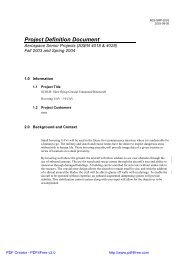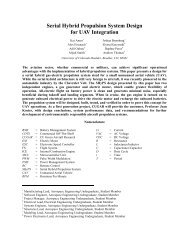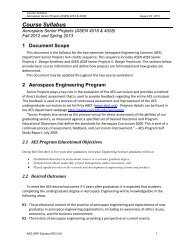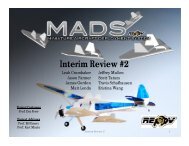PFR - Aerospace Engineering Sciences Senior Design Projects ...
PFR - Aerospace Engineering Sciences Senior Design Projects ...
PFR - Aerospace Engineering Sciences Senior Design Projects ...
You also want an ePaper? Increase the reach of your titles
YUMPU automatically turns print PDFs into web optimized ePapers that Google loves.
Project Final Report – CUDBF April 30 th , 2009<br />
ASEN 4028: <strong>Aerospace</strong> <strong>Senior</strong> <strong>Projects</strong><br />
As shown in the preceding paragraphs, stability for the designed aircraft configuration will not<br />
be an issue and therefore will not be an obstacle in accomplishing the mission goals.<br />
8.1.6 Drag Analysis<br />
With payloads that don’t seem very aerodynamic such as the water bottle, it is necessary to<br />
ensure that there is enough available thrust to overcome the drag predicted. The drag analysis<br />
was performed in a program called PowerFLOW [15] . PowerFLOW is a computational fluid<br />
dynamics tool used to aid in the analysis and visualization of internal and external flows using<br />
the Lattice-Boltzmann Method (LBM). External 3-dimensional, incompressible flow was used<br />
for the simulations for drag estimates obtained from this tool. PowerFLOW consists of two<br />
modules used to set up a simulation and one used to analyze flow results. The module used to<br />
setup the simulation case is called PowerCASE [16] and the module used to visualize the flow<br />
results is called PowerVIZ [17] .<br />
The drag on the airplane was predicted for the case with four rockets on the airplane, the bottle<br />
on the airplane, the bottle, the rocket, and the airplane without payloads. The drag results from<br />
the bottle and the rocket in a simulation volume were compared to hand calculations to<br />
determine if the results produced by PowerFLOW were reasonable. The results from the drag on<br />
the payload alone as predicted by the software and as calculated by hand are shown in Table 13:<br />
Table 13: Drag Prediction on the Payload Calculated by Hand and in PowerFLOW<br />
Payload Drag (By Hand) Re C D Drag (PowerFLOW)<br />
Rocket 0.082 lb 527473 0.75 0.081 lb<br />
Bottle 1.64 lb 998681 0.85 0.531 lb<br />
As seen in the preceding table, it is clear that the drag estimate was very close for the rocket but<br />
for the bottle, the hand calculation was predicted to be much larger than the result from<br />
PowerFLOW. The purpose of calculating drag by hand was to verify the results from<br />
PowerFLOW and evaluate the discrepancy, if any. The reason that the hand calculation for the<br />
drag on the rocket was so similar to the result obtained from PowerFLOW is because the drag<br />
coefficient for the exact rocket being used was found to be 0.75 [18] .<br />
On the other hand, for the bottle, the drag coefficient was estimated as a cylinder from Horener<br />
[19] . The bottle being used on the airplane is not a perfect cylinder. This is responsible for the<br />
difference in drag estimates for the bottle. Because the drag prediction for the rocket done by<br />
hand was accurate (since the correct drag coefficient was used) and this value was different from<br />
PowerFLOW by 0.001 lb, it is valid to assume that the predictions from PowerFLOW are<br />
accurate with the caveat that the cases were set up correctly.<br />
72
















